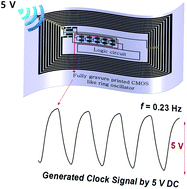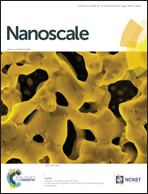Fully gravure printed complementary carbon nanotube TFTs for a clock signal generator using an epoxy-imine based cross-linker as an n-dopant and encapsulant†
Abstract
Printed p-type single walled carbon nanotube (SWCNT) based circuits exhibit high power dissipation owing to their thick printed dielectric layers (>2 μm) and long channels (>100 μm). In order to reduce the static power dissipation of printed SWCNT-base circuits while maintaining the same printing conditions and channel lengths, complementary metal–oxide-semiconductor (CMOS) based circuits are more ideal. These circuits, however, have not been successfully implemented in a scalable printing platform due to unstable threshold voltages of n-doped SWCNT based thin film transistors (TFTs). In this work, a thermally curable epoxy-imine-based n-doping ink is presented for achieving uniform doping and sealing of SWCNT layers by gravure printing. After printing the n-doping ink, the ink is cured to initiate a cross-linking reaction to seal the n-doped SWCNT-TFTs so that the threshold voltage of the n-doped SWCNT-TFTs is stabilized. Flexible CMOS ring oscillators using such n-doped SWCNT-TFTs combined with the intrinsically p-type SWCNT-TFTs can generate a 0.2 Hz clock signal with significantly lower power consumption compared to similarly printed p-type only TFT based ring oscillators. Moving forward, this CMOS flexible ring oscillator can be practically used to develop fully printed inexpensive wireless sensor tags.


 Please wait while we load your content...
Please wait while we load your content...